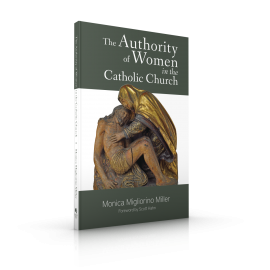By Monica Migliorino Miller, Ph.D.
Dr. Monica Migliorino Miller is author of The Authority of Women in the Catholic Church. She is an Associate Professor of religious studies at Madonna University and is the director of Citizens for a Pro-Life Society.

On March 19, 2019, the Feast of St. Joseph, seven pro-lifers entered two abortion centers in Washington, D.C. and spoke to women seated in the waiting room scheduled for abortions. They were participating in Red Rose Rescues of the unborn. They hoped to convince the women to choose life literally minutes before they walk into the backrooms where the unborn are taken from them forever. Their philosophy is to “enter the dark holes of the poor” in the words of St. Mother Teresa, and be a light in the darkness. But abortion is a peculiar kind of darkness and the mission of pro-life work is thus also peculiar. These Red Rose Rescuers, indeed all pro-lifers, are not “simply” working to restore the right to life. Pro-lifers are putting the world back together again as abortion attacks the meaning of human relatedness.
Abortion does not simply kill unborn children. Abortion does something else that is equally dangerous—it attacks the very essence of how human beings are in relation to one another. Abortion undoes the most basic and intimate human bonds—the bonds of the family upon which society and indeed all of civilization are dependent. Abortion, practiced under Roe v. Wade, is not so much a liberty as it is a raw, unmitigated power. This power of life and death over unborn children has been placed in the hands of women and with it the power to undo all human relatedness.
Radical feminism is ultimately not about rights, but about power, and the ultimate feminist power is abortion. Roe v. Wade itself is a type of feminist manifesto rooted in a particular philosophy about power, especially about how power is attained. Roe refused to recognize the humanity and the legal personhood of unborn children. By refusing to recognize the personhood of the unborn, Roe placed fetal children outside of all human relations. This disfranchisement from the circle of the human family and human rights is enough to facilitate their deaths.
But Roe also did something to women. Before a woman could have absolute power over the life of her child, Roe first had to place the woman in complete isolation from all others—from her boyfriend, from her husband, from her parents. The woman had to be isolated from anyone who could claim to be in relation to her and her unborn baby. Once the woman is severed from others she may in her sheer autonomy finally sever herself from her own child.
Roe created the autonomous woman. This is the woman who stands alone, the absolute individual who, once disconnected from others, may then control or destroy the lives of others because she is placed outside of any intrinsic relation to them.
The “right to privacy” is the key to understanding what the Supreme Court decision did to women. Ultimately, privacy in Roe not only means that people may make reproductive decisions free from government intrusion and regulation. In Roe, practically speaking, privacy is the zone of privacy around the woman. It is synonymous with her isolation, and this sort of privacy is a deadly thing. This privacy rests on the assumption that human freedom is freedom from being in relation to others because the very presence of others compromises my freedom and my selfhood. Abortion in America is acting out the Sartrean philosophy that “Hell is other people.” To be free, the other who calls me into relation and responsibility must be annihilated.
The core of feminist philosophy is that the woman—and the woman alone—must have absolute control over her reproductive powers. It is a feminist tenet that the biology of a woman keeps her enslaved. Feminine biology is deemed a burden because it is constantly changing due to the biological rhythms of the feminine cycle. In a sense a woman can never be free of her body in the way that male physical constancy allows a man to be “free”. But more important than this, the feminist’s desire to have absolute control over her reproductive powers stems from the fact that female biology intrinsically places the woman in relation to others. The woman’s life-giving powers bind her to others and bind others to her. Only when the woman is free from such human connectedness can she claim the radical autonomy that is necessary to have control over others. That popular pro-abortion slogan: “I have a right to control my own body” means women have the right to cast others out of relation to them and deny that they are in a moral relation to others.
Once the woman places herself in isolation from others by refusing to allow her sexuality to be at the service of life and the building up of human community, society is faced with the breakdown of its moral order and foundation. George Gilder in his very insightful 1973 book Sexual Suicide (later re-issued as Men and Marriage) understood very well the meaning of feminine authority. Between men and women the female is the life-giving center towards which male creative energy and labor is ordered. When male sexual behavior is no longer placed in the service of the familially-centered reproductive powers of the woman, the primary means by which social and moral order in the world is maintained collapses. Male energy is now disassociated from the feminine cycle of reproduction; instead of being put in the service of life it serves only chaos and death in a reversal of civilization in which women end up, no longer honored, but used and then abandoned.
Because women are the keepers of the mystery of life, a woman’s authority lies in calling the male to the service of life and the family of which she is the center. Abortion as the power of alienation, instead of calling men to their familial responsibility for others, “frees” them from any creative masculine role whatsoever.
The fact that a woman in pregnancy actually bears another person within her own body is a great anthropological lesson. We learn from this kind of utter dependency and closeness, precisely through a woman’s body, whose womb is a space for another person, the meaning of being human. To be human is to be connected to another—to be in relation—and again it is the woman who is the center of this human connectedness. For a human being to live, even after birth, he must be connected to another. Pregnancy assures that the child from the very beginning of his existence will be personally related to another. It is this experience of being personally related to another which confers the most lasting and profound human identity.
Saint John Paul II was fond of insisting: “Woman is entrusted with the human.” What does this really mean but that women will preserve the personal identity of the individual from being lost or effaced by all that is not human—all that, especially in our technological age, would reduce a man to a thing. And the first way to treat a man as a thing is to make him unrelated to everything else that is human. The primary bulwark against such dehumanization is the pregnant woman who claims the unborn child as her own.
“He made war upon the woman.” So states Revelation 12:13. This is the woman who gives life by bearing a Son. The Devil must attack this kind of woman. Her elimination creates a portal through which God’s good creation can be undone by the other woman—the one who commits fornication with the kings of the earth and who is drunk with the blood of men. The first Woman overcomes the Devil and restores order to the world precisely by giving life.
During Lent the Church calls us to focus on the Passion of the Savior. At the foot of the cross stood Mary—united with her Son in His suffering. This is the ultimate way to focus on the Passion of the Savior—not simply to ponder it, but to be with Him in His time of abandonment. Mary is the ultimate model of human relatedness. She stays with the Rejected One—joins her lot in with His—the ultimate fulfillment of human relatedness as Mother to Son united in suffering. The Red Rose Rescuers, and anyone who calls women and men to turn from the killing of their children, stand with the Rejected One again. This Lent let us go to the dark holes of the poor and bring the Light to those engulfed in the darkness of a power that severs human beings one from another, and with His Light put the world back together again.
You Might Also Like
 Examining one of the most divisive issues today, The Authority of Women in the Catholic Church details the role of women in the covenant of salvation. Dr. Monica Migliorino Miller defines authentic feminine authority with the support of Scripture, the writings of the Church Fathers, contemporary theological insights, and historical witnesses to the role of women in the Catholic Church.
Examining one of the most divisive issues today, The Authority of Women in the Catholic Church details the role of women in the covenant of salvation. Dr. Monica Migliorino Miller defines authentic feminine authority with the support of Scripture, the writings of the Church Fathers, contemporary theological insights, and historical witnesses to the role of women in the Catholic Church.